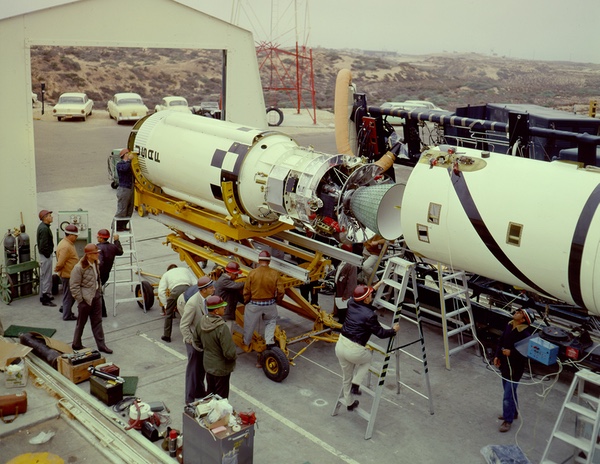Lollipops and ASATsby Dwayne A. Day
|
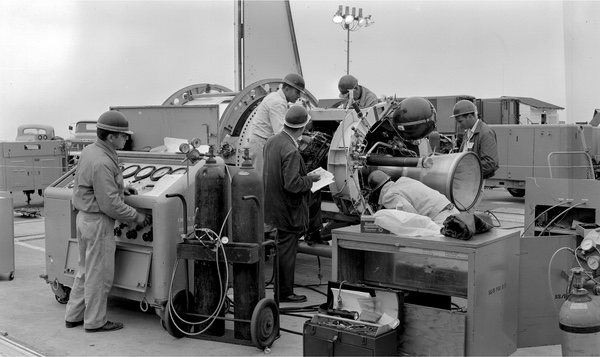 Technicians preparing the Discoverer 13 mission for launch. This satellite carried a payload that detected that it was being tracked by Soviet radars. That proved to be erroneous and the satellite was actually detecting American radar signals. (credit: Peter Hunter Collection) |
Part of the impetus for creating SOCTOP was the proliferation of new and unknown Soviet radar systems. The big HEN HOUSE radars that had appeared in U-2 spyplane and satellite photos were potentially capable of tracking satellites in orbit. But there were also unknown antennas showing up on Soviet trawlers and tracking ships, and intelligence analysts were concerned that these could be directed at American satellites.
| There were also unknown antennas showing up on Soviet trawlers and tracking ships, and intelligence analysts were concerned that these could be directed at American satellites. |
After the creation of the secretive National Reconnaissance Office in summer 1961, and once CORONA missions were flying on a regular basis, program managers began fitting small electronic payloads to the aft rack of the Agena that served as both a rocket second stage and the spacecraft bus in orbit. An electronic box and antenna could be mounted to the side of an Agena so that the antenna was pointed down toward the Earth. These were labeled AFTRACK payloads and they had a multitude of different missions collecting signals intelligence during their brief stays in low Earth orbit.
The AFTRACK program was managed by the NRO’s “Program A” office in Los Angeles. Program A went by the more formal name of the Secretary of the Air Force Special Projects Office, or SAFSP, often simply referred to as “Special Projects” by those in the know. Many AFTRACK payloads were designed to detect signals from specific air search radars inside the Soviet Union to assist in determining their characteristics and locations. Such information was useful for the Air Force in developing countermeasures to enable Strategic Air Command bombers to penetrate Soviet airspace.
SOCTOP was followed by a substantially improved version known as STOPPER, “designed to detect skin-tracking and attempts at command probing,” according to an official account of these payloads. STOPPER also had possible use as a signals intelligence collector.[2] STOPPER had been built for flight on the Samos E-6 reconnaissance satellite (also known as the 698BJ vehicle.) But Samos E-6 was cancelled in 1962 before the STOPPER system was ready. STOPPER was also equipped with a tape recorder, which enabled it to record signals when out of communication with the ground. Eventually, six STOPPERS were flown on dedicated signals intelligence satellites as additional payloads, with wildly differing results, and some equipment failures.
BIT was the follow-on to STOPPER and was started by SAFSP in 1964.[3] Unlike the other AFTRACK payloads that were primarily gathering intelligence data, BIT was a dedicated “vulnerability” payload. An official history of American signals intelligence (SIGINT) satellites explained BIT’s mission: “The objective was to determine if Soviet or other hostile radars were actually tracking or trying to interfere with the electronics on the vehicle and the degree of success they achieved. A byproduct of this activity was verification of the tracking radar characteristics or discovery of new variations in their patterns not seen previously. The payload configuration changed as new and improved tracking radars appeared and as collection payload technology improved.”[4]
Benefitting from advances in electronics, BIT also improved on STOPPER’s capabilities. The BIT receivers were built by EDL-Sylvania at Mountain View, California (commonly known as EDL at the time, later known as Electronic Defense Laboratories.) The finished units were delivered to Lockheed Missiles and Space Company in Sunnyvale, which was responsible for overseeing all systems integration, vehicle installation, and checkout. Antennas were built by another Lockheed department and integrated by the Lockheed research payloads group.
The payloads mounted on the aft rack of the Agena had a requirement for minimal weight and power demands, and data storage and readout was via the Agena telemetry system. A goal was not just detection of the radars’ main beams, but also sufficient sensitivity to get good reception of radar sidelobes, energy that leaked off the sides of the main radar beam. Capturing the sidelobes increased the number of radar interceptions. Although BIT was initially flown on CORONA area-search reconnaissance satellites, eventually it was also included on GAMBIT high-resolution reconnaissance satellites as well.
BITs and more BITs
Numerous BIT payloads were carried on CORONA and, later, on GAMBIT reconnaissance satellites throughout the 1960s, and the hardware was updated based upon further information about the HEN HOUSE and other space tracking radars used by the Soviet Union. BIT I was a fixed-tune, tuned radio frequency receiver covering the frequency range 153–163 megahertz. It was also equipped to prevent the unwanted recording of Soviet Tall King air defense radars that worked in the same frequency range. Tall King radars were deployed throughout the Soviet Union and were not a threat to satellites. Their signals were collected by payloads on other satellites.
| Unlike the other AFTRACK payloads that were primarily gathering intelligence data, BIT was a dedicated “vulnerability” payload. |
BIT II was designed to operate in the 150–300 megahertz range and was equipped to detect interlaced pulses from two radars. BIT III, VI, VII and VIII were proposed receivers that were not pursued to hardware status. BIT IV was introduced in 1967. Based upon better knowledge of Soviet radar systems, it had a fixed tune receiver for the 152–154 megahertz coverage, and a sweeping receiver for the range 700–1000 megahertz.
BIT I and II payloads were included in CORONA missions. BIT IV was added to CORONA missions in early 1967, and in December 1967 it was also added to the tenth KH-8 GAMBIT-3 mission. From then on was included in all GAMBIT missions until replaced by later systems.
BIT IVA was a modification introduced in May 1969, adding coverage of 1880–2020 and 2105–2245 megahertz. By mid-1969 it was used on all subsequent CORONA and GAMBIT reconnaissance missions. BIT IVA—which apparently also was designated BIT IV-7—was added to GAMBIT missions by 1971, to be replaced by BIT IX (also designated BIT IX-6) on later GAMBIT missions. It employed three separate receivers covering frequency ranges that remain classified to this day.
BIT V used two receivers, one for 153 to 163 megahertz, and the other sweeping through 700–2200 megahertz. It was used on seven GAMBIT missions beginning in March 1968 and ending in June 1969, it was eventually replaced by BIT IVA. All of these units were built by EDL. As the number of units produced increased, the SAFSP in Los Angeles consolidated management of them into a separate office.
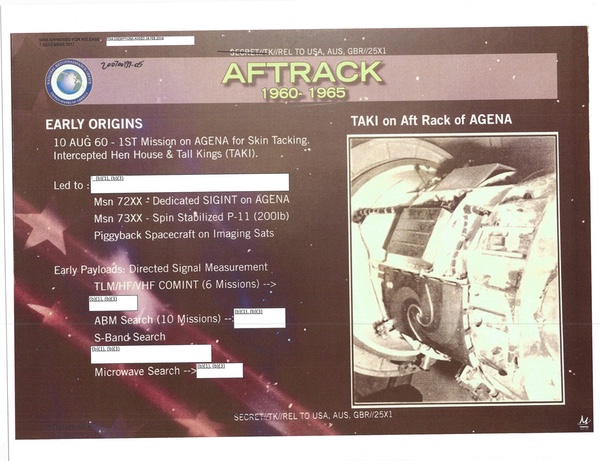 The spiral antenna visible on the after rack of this Agena spacecraft was used for detecting Soviet radar systems. American reconnaissance satellites during the 1960s were often equipped with a wire loop "lollipop" antenna on an inflatable boom that deployed from the same general location on the spacecraft. It was used to detect if the satellite was being tracked from the ground. (credit: NRO) |
Lollipops
The BIT I used a half-wave loop antenna mounted directly on the receiver box cover. BIT II and succeeding designs used an expandable antenna called a Lollipop. This was a planar logarithmic spiral of gold deposited on a Dacron cloth substrate. The cloth was mounted within an inflatable tubular structure which was packed into a small box mounted on the aft rack of the Agena until it was deployed.
For CORONA missions, BIT reports were produced after each mission to indicate if the spacecraft had received anything. The reports included orbit by orbit summary of intercept opportunities for each known radar site, actual intercepts—both main and sidelobe interceptions—time and duration, track or scan, and comments on any patterns of activity and unusual signal characteristics.
For the GAMBIT missions, a new ground processing system was developed to speed message reports to reduce cost and time. The plan was to continue to make the program responsive to changes in how the Soviet Union operated their space tracking radars. “Rapid review and analysis of BIT data is considered vital to establishing patterns of Soviet antisatellite activity and to anticipating the character and timing of possible hostile interference,” a program summary explained. Because the NRO was launching a couple of satellites a month, it was vital to keep tabs on any emerging threat.
| It is unknown if the GAMBIT launched in January 1969 had a BIT payload on board, although there is no indication it did. American intelligence officials certainly would have been very interested if Soviet radars were tracking the GAMBIT satellite to make an interception with Kosmos 264. |
By 1968, the BIT boxes had been consolidated under a new title that remains classified. The BIT box output was distributed to the National Security Agency and other interested agencies. That data was sometimes used to program operations for other satellites and even assist in the design of new signals intelligence payloads. Although the NSA did not have any role in processing the BIT data, the agency did benefit from the results.[5]
According to the program summary, by 1969 “a substantial amount of data has been obtained on HEN HOUSE signal characteristics and the operational patterns of individual sites.” By April 1969, the BIT payloads were also providing consistent coverage of Soviet S-band radar emissions, but only a single intercept had been obtained, in August 1969, from KH-4B CORONA mission 1107.
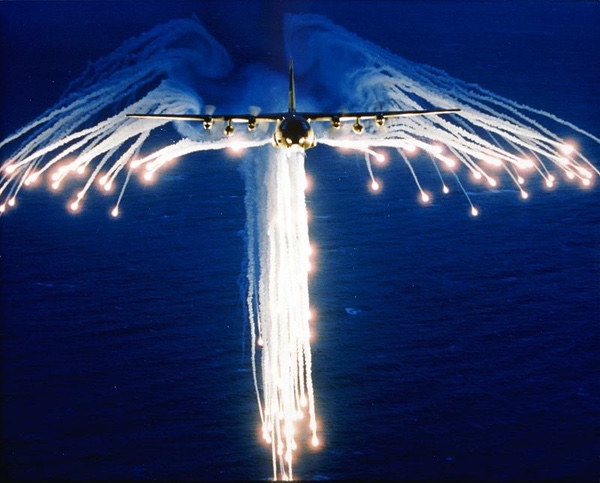 A C-130 aircraft firing infrared flares to deflect infrared missiles. (credit: Wikipedia/TidusTia) |
Tense maneuvers
On January 22, 1969, the US Air Force launched a Titan IIIB-Agena D rocket from Vandenberg Air Force Base in California. Atop the rocket was the nineteenth GAMBIT-3, designated Mission 4319. Available records imply that it did not include a BIT vulnerability payload.[6]
The GAMBIT was supposed to enter an essentially circular orbit. But the Agena malfunctioned and its rocket engine fired far longer than it was supposed to. The spacecraft went into an orbit that was 132 kilometers at its lowest point and 1090 kilometers at its highest point, inclined 106.1 degrees to the Equator.
The next day—January 23, 1969—the Soviet Union launched its second Zenit-4M high-resolution reconnaissance satellite, designated Kosmos-264. Although the photographic capabilities of the Zenit-4M remain classified today, physics indicates that it could not have been anywhere near as powerful as the GAMBIT-3, because it lacked the large aperture mirrors of the American satellite.
In contrast to the austere cylinder of the GAMBIT-3, the Zenit-4M was a jumble of shapes. It was based on the Vostok manned spacecraft and had a large pressurized sphere at the middle and a semi-conical support structure on the bottom, making it look somewhat like a squashed ice cream cone. The Zenit-4M was an improvement over its predecessors by adding an Isayev orbit adjust engine atop the sphere, enabling it to boost its orbit and extend its lifetime, and making its appearance even uglier than earlier versions. Because this was only the second launch, the system was still being tested, and thus during the mission the Soviet flight controllers fired the Isayev engine several times, adjusting the orbit of their satellite—and gaining the attention of the United States.
According to an official history, “Critical to US Security: The Gambit and Hexagon Satellite Reconnaissance Systems,” produced by the National Reconnaissance Office and released in 2012, some at the National Reconnaissance Office quickly took notice of Kosmos-264’s orbital maneuvers:
“Gambit program officials strongly believed that neither the Soviets, nor anyone else, knew the capability of the Gambit program. In 1969, however, officials held their breath as a Soviet satellite, Kosmos 264, began to make orbital adjustments that U.S. engineers calculated would bring it within 70 miles [113 kilometers] of Gambit-3. Eventually the two satellites passed within 15 miles [24 kilometers] of each other as NRO controllers held their breath, wondering if Kosmos was a ‘killer satellite.’”
Their concern was likely prompted by something that had happened only a few months earlier. In October and November 1968, the Soviets conducted several tests of their new anti-satellite system. A target satellite, Kosmos-248, was launched into a roughly circular orbit. The ASAT worked by going into an orbit similar to its target, getting nearby during apogee, when both were moving the slowest, and then firing a shotgun-like explosive in the direction of its target. Kosmos-249, either by design or malfunction (sources disagree) failed to destroy Kosmos-248 in late October. But Kosmos-252 launched on November first from the Baikonur Cosmodrome, and that same day it maneuvered near Kosmos-248 and exploded, apparently successfully destroying the target satellite. The Americans had monitored the Soviet ASAT’s progress—there was no way that they could miss the debris field that the explosion generated—and it made them nervous that their own satellites were now in Soviet crosshairs.
| By 1965, the CIA had conducted studies of “chaff, decoy, radar cross section reduction, as well as sophisticated electronic jamming systems.” A decoy system was at that time nearly ready for deployment. |
It is unknown if the GAMBIT launched in January 1969 had a BIT payload on board, although there is no indication it did. American intelligence officials certainly would have been very interested if Soviet radars were tracking the GAMBIT satellite to make an interception with Kosmos 264. In the end, Kosmos 264 was not an ASAT, but the incident certainly highlighted the need to determine if American satellites were being targeted for destruction. BIT IX payloads were soon included in the HEXAGON satellites that replaced the CORONA satellites, began launching in 1971 and flew until the mid-1980s.
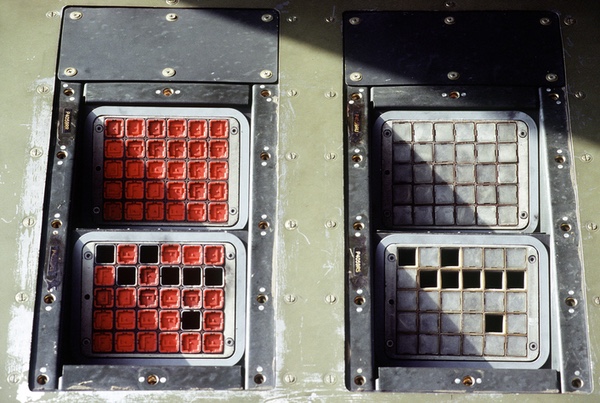 Flare and radar chaff dispensers on a C-130 aircraft. It is possible that US spacecraft have carried such countermeasures devices. (credit: Staff Sergeant David W. Richards) |
Attack reporting
Although some information on the BIT payloads has been released, the larger picture of what these electronic boxes did and why is still unclear. Simply reporting that a satellite had been tracked from the ground had limited utility unless something could be done in event of attack. The NRO’s 2015 review and declassification guide indicates that information less than 50 years old on “defensive countermeasures” that satellites could take should be deleted from released documents, and thus very little information has been released.
However, there is some information available. As early as January 1963 the CIA began discussing possible techniques for shielding CORONA satellites from interference as well as possible countermeasures to defend them from attack. There were many options to evaluate, including methods to reduce the radar and optical signatures of the satellite as well as possible shielding. They were close to finishing a “pellet attack reporter” that would indicate if a satellite had been hit by shrapnel.[7]
By 1965, the CIA had conducted studies of “chaff, decoy, radar cross section reduction, as well as sophisticated electronic jamming systems.” A decoy system was at that time nearly ready for deployment. The problem was that any such countermeasures system added mass, possibly impacting satellite performance.[8] The best option was probably to move the satellite out of the way to spoil any attack. CORONA satellites were equipped with “Drag Make-Up Units” or DMUs, small solid-propellant rockets that would boost the satellite after its orbit had decayed during a mission. The DMUs could also be used in case of an attack.
Additional information declassified in 2017 adds a bit more to the story. An April 1971 cable from Brigadier General Lew Allen, who headed SAFSP in Los Angeles, to the Director of the NRO John McLucas in Washington, DC, about a proposed upgrade to the GAMBIT satellite mentioned some possible subsystems. “I do not plan to include attack reporter system or vulnerability measures in the initial development,” Allen wrote. “We will consider interface provisions and a weight allocation which would be traded against expendables…”[9]
General Allen’s mention of an “attack reporter system” is unusual for NRO documents, but is probably linked to the “pellet-attack reporter” that the CIA was working on in 1963. The GAMBIT satellite had adopted a small secondary propulsion system that could boost the satellite’s orbit (better than the solid propellant DMUs first used on CORONA). Moving out of the way of an attack would require fuel and would possibly limit that satellite’s ability to perform its mission.
What the satellites also could have included was a radar warning receiver to indicate if they had been targeted by a Soviet interceptor in orbit, but no information on any such systems has been declassified. During the 1960s, American military aircraft were equipped with flares for deceiving infrared sensors and radar-deceiving chaff. Perhaps GAMBIT included those mounted to the aft end of its Agena, just in case a Soviet spacecraft got a little too close for comfort. The ubiquitous BIT system may have been only one of several black boxes attached to the aft rack of the Agena.[10]
References
- Major General David D. Bradburn, U.S. Air Force, Colonel John O. Copley, U.S. Air Force, Raymond B. Potts, National Security Agency, [deleted name], National Security Agency, “The SIGINT Satellite Story,” National Reconnaissance Office, 1994, p. 125.
- John L. Martin, Jr., Brigadier General, USAF, Director, NRO Staff, Memorandum for Chairman COMOR, “STOPPER Payload SIGINT Potential,” no date.
- “BIT ELINT Program,” no date.
- “The SIGINT Satellite Story,” pp. 125-126.
- Ibid., pp. 126-127.
- See: National Security Agency, “NSA in Space,” April 1975, pdf pages 140-141, which do not indicate any BIT payloads on a January 1969 GAMBIT mission.
- [Deleted], Development Division, OSA-DD/E, Central Intelligence Agency, Memorandum for the Record, “9-10 January Meeting on Satellite Vulnerability,” January 8, 1963.
- Albert D. Wheelon, Deputy Director for Science and Technology, Central Intelligence Agency, Memorandum for Director of Central Intelligence, “Vulnerability of the CORONA System to Soviet Countermeasures,” September 16, 1965.
- General Allen to Dr. McLucas, “Interim System Film Readout GAMBIT Status,” April 30, 1971.
- See also: David H. Onkst, “Check and Counter-Check: The CIA’s and NRO’s Response to Soviet Anti-Satellite Systems, 1962-1971,” Journal of the British Interplanetary Society, Vol. 51, No. 8, August 1998, pp. 301-308.
Note: we are using a new commenting system, which may require you to create a new account.
